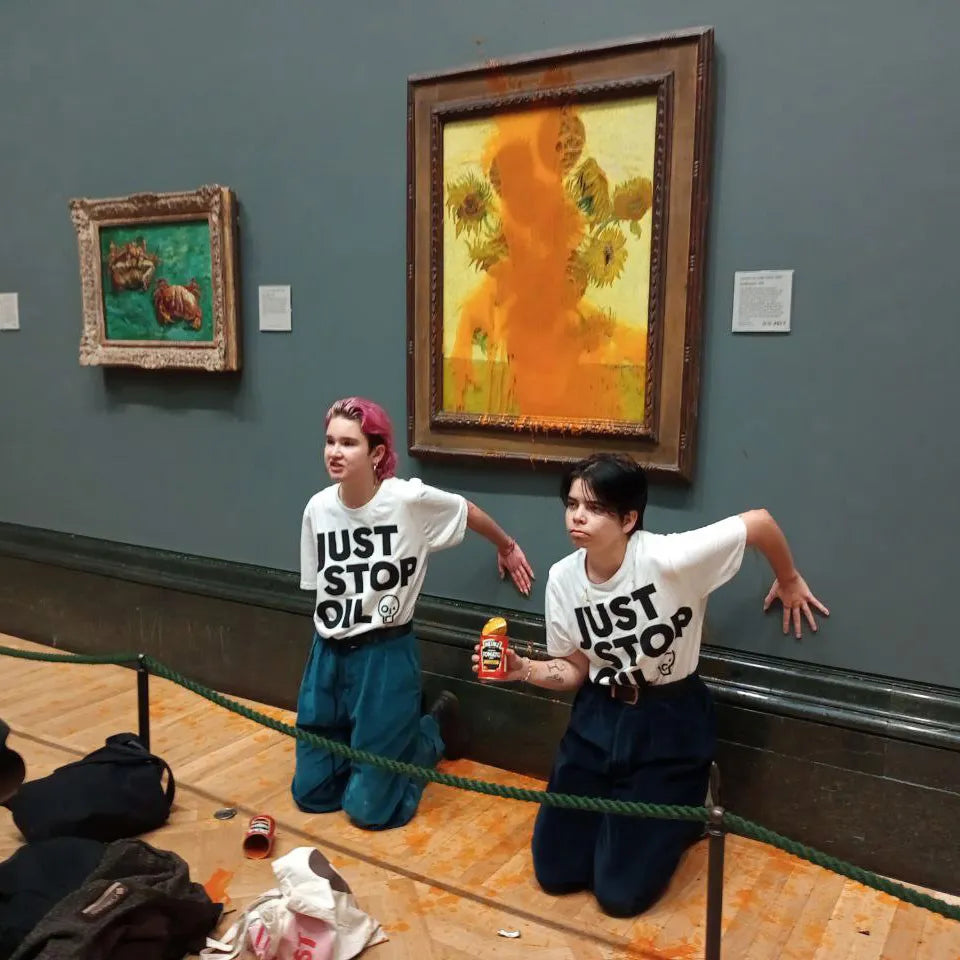Featured image: Van Gogh's Sunflowers - London, 2022
In recent years, a new and controversial form of climate protest has emerged, capturing global headlines: activists targeting priceless works of art.
"Why do activists target art?" Activists target art to leverage its cultural and emotional significance, aiming to generate widespread attention for the climate crisis through shocking, media-friendly actions that provoke both support and controversy.

Leonardo da Vinci's Mona Lisa - Paris, 2022
These protests, often involving symbolic actions like gluing themselves to frames or throwing substances at protected artworks, aim to draw attention to the urgent climate crisis. But what motivates these activists to choose art as their stage? This article delves into the reasons behind these protests, their historical precedents, and the broader implications for both the climate movement and society.
Explore our curated selection of contemporary artists from around the globe.
Naturalist Gallery offers artist representation internationally. Apply your art.
The Power of Art as a Cultural Touchstone
Art holds a unique place in human society. It represents cultural heritage, collective memory, and human achievement. By targeting art, activists tap into these deep emotional connections, leveraging the symbolic power of art to highlight the severity of the climate crisis.

Monet's Les Meules (Haystacks) - Potsdam, 2022
Why Art?
- Universal Appeal: Art is universally recognized and revered, transcending cultural and linguistic barriers. This makes it an ideal platform for protests that aim to reach a global audience.
- Emotional Impact: People often have strong emotional connections to famous artworks, and seeing them "under attack" elicits a visceral reaction. Activists believe that this emotional response can be redirected to raise awareness about the climate emergency.
- Media Magnet: Art-related protests are almost guaranteed to attract media attention. The juxtaposition of something as refined as art with the rawness of protest creates a compelling narrative that journalists are eager to cover.
Historical Precedents: Civil Disobedience in the Arts

Andy Warhol's Campbell's Soup Cans - Canberra, 2022
The strategy of targeting art for protest is not new. Historical examples of art-related civil disobedience offer important context for understanding today’s climate protests.
Key Historical Examples:
- The Suffragettes: In the early 20th century, suffragettes slashed paintings in British galleries as part of their campaign for women’s voting rights. These acts were intended to shock the public and force a conversation about women's suffrage.
- Vietnam War Protests: During the 1960s, anti-war activists targeted art exhibitions to draw attention to the conflict in Vietnam. By disrupting cultural events, they sought to convey the message that normal life could not continue while the war raged on.
- Modern Echoes: Climate activists see themselves as part of this tradition, using disruptive tactics to force society to confront uncomfortable truths. By aligning themselves with past movements, they aim to validate their actions and underscore the urgency of their cause.
The Mechanics of Media Amplification

Vermeer's Girl with a Pearl Earring - The Hague, 2022
One of the primary objectives of these art-related protests is to maximize media exposure. In today’s fast-paced digital landscape, a protest that targets art can quickly become a global sensation.
How It Works:
- Going Viral: The dramatic nature of these protests—whether it’s throwing soup at Van Gogh’s "Sunflowers" or smearing cake on the Mona Lisa—ensures that they will be widely shared on social media. These viral moments are critical for reaching audiences who might not otherwise engage with climate issues.
- Media Framing: However, media coverage can be a double-edged sword. While the protests succeed in drawing attention, the focus often shifts to the act of "vandalism" rather than the underlying message. This shift can dilute the intended impact and even generate backlash.
- Public Perception: Studies, such as those conducted by climate scientist Michael Mann, suggest that these protests can polarize public opinion. While some viewers are inspired by the boldness of the actions, others are repelled, seeing them as counterproductive or even disrespectful.
The Debate: Effective Activism or Counterproductive Stunt?
The effectiveness of these protests is hotly debated within both the climate movement and the broader public.
Supporters' Perspective:

Picasso’s Massacre in Korea - Melbourne, 2022
- Desperate Times, Desperate Measures: Proponents argue that traditional methods of advocacy have failed to bring about meaningful change. In their view, disruptive actions are necessary to jolt society out of complacency and force a reckoning with the climate crisis.
- Historical Validation: Activists often point to successful movements in history where civil disobedience played a crucial role in achieving progress. They believe that the shock value of targeting art is justified if it sparks the necessary conversation.
Critics' Concerns:

Botticelli's The Birth of Venus - Florence, 2022
- Alienating Allies: Critics, including some within the climate movement, argue that these protests risk alienating potential supporters. By associating climate activism with the perceived desecration of cultural treasures, they worry that the movement could lose public sympathy.
- Misplaced Focus: Some detractors believe that the protests are misguided, targeting symbols rather than the actual perpetrators of environmental destruction. They argue that such actions might distract from more direct and effective forms of activism.
The Broader Implications for Activism and Society

Goya’s The Naked Maja - Madrid, 2022
As the climate crisis deepens, the debate over the most effective forms of protest will continue. Art-targeted protests raise important questions about the role of symbolism in activism, the ethics of civil disobedience, and the potential for backlash in an increasingly polarized world.
Future of Climate Protests:
- Evolving Tactics: Activists may refine their tactics in response to public reaction, seeking new ways to balance shock value with constructive dialogue.
- Long-Term Impact: The long-term effectiveness of these protests will depend on whether they can sustain public attention and translate media coverage into meaningful action on climate change.
- Cultural Reflection: These protests also force society to reflect on what it values—art, nature, or both—and how those values can coexist in a world under threat from environmental degradation.
Art-targeted climate protests are a bold and controversial strategy that highlights the desperate need for action in the face of environmental catastrophe. While their effectiveness remains a subject of debate, these protests undeniably force a global conversation about the climate crisis, the role of art in society, and the power of activism to drive change. As the world continues to grapple with these issues, the intersection of art and activism will likely remain a potent and contentious battleground.
Learn more About Naturalist Gallery of Contemporary Art.

Van Gogh’s Peach Trees in Blossom - Rome, 2023
You may also find the following articles helpful:
The 14 Essential Artists of Impressionism
Expressionism: 20 Iconic Paintings & Their Artists
Renaissance Art: Origins, Influences, and Key Figures
Classical Art Movement: Exploring the History, Artists, and Artworks
Figurative Art: Understanding, Collecting, and Appreciating the Style
Daily Routines of Famous Artists: Learn from the Masters
Top 12 Controversial Artworks That Changed Art History
Tracing the History of Humans and Art

Klimt’s Death and Life - Vienna, 2023

